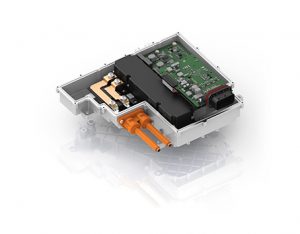ZF to produce 800-volt power components for premium electric vehicles

ZF reinforces the design trend among automotive manufacturers, towards high-voltage vehicle power supplies for 800 volts rather than the current 400 volt systems, with the development and production of corresponding components for the electric driveline. The trend is responding to the requirement for faster charging times for battery electric vehicles, with the introduction of modified on-board power system architectures.
At the core of the new components is power electronics using silicon carbide as a semiconductor, a new chip technology that ZF uses for the first time in premium vehicle production instead of silicon transistors, obtaining a reduction of internal switching losses. As power electronics have a very high energy throughput during electric driving and recuperation, therefore the efficiency of the entire electric driveline increases, with a positive effect on the range. ZF first used silicon carbide power electronics in the Formula E racing series, and the experience and insights gained from this application will be continuously incorporated into wider volume production development.
“It is becoming apparent that the 800-volt architecture will become established in future premium electric or electric sports cars, whereas the 400-volt architecture will remain the standard in the volume market – says Bert Hellwig, responsible for the system development of electric drives at ZF -. For years, we have been supplying 400-volt technology for volume production, this year, we are preparing the start of production for 800-volt applications”.
Charging time plays an important role in the user-friendliness of electric vehicles. If electric cars are to become sustainable over longer distances, the battery must be capable of reaching almost fully charged capacity within an hour. A fundamental problem of quick charging is heat generation from higher currents. This requires cable design to be thicker or cooled. Incorporating this into 400-volt architectures creates disadvantages in terms of vehicle weight and the complexity of the charging infrastructure. The solution is a vehicle power supply architecture that has been designed for higher performance from the outset.
For this reason, many automotive manufacturers are planning future vehicles with higher, 800-volt systems. An essential component of the electric driveline is the power electronics, whose main task is to convert the different types of electrical energy. Power electronics for 400-volt architectures have long been part of the ZF volume production product portfolio but the company also supplies new core technology for drives with increased voltage: “We are currently working on the start of production for several premium 800-volt projects – continues Hellwig -. We supply a Chinese OEM with the complete electric driveline, including power electronics, for several models. For a European sports car manufacturer, ZF provides power electronics for a high-voltage application”.
Further premium production launches are already on the horizon. While designing power electronics for 800-volts, ZF will be in fact able to expand synergies between passenger cars and other applications.









